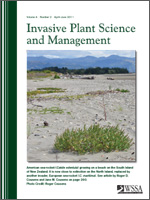We evaluated the efficacy of the biological control agent, red-headed leafy spurge stem borer, against the nonnative invasive plant leafy spurge. Our three treatments were release of the biological control agent into uncaged plots, release of the biological control agent into plots caged to prevent agent escape, and control plots caged to prevent agent entry. These treatments were replicated three times at six sites in the western United States. We measured leafy spurge biomass for 1 or 2 yr following release. We also measured the percentage of leafy spurge stems showing evidence of red-headed leafy spurge stem borer oviposition for either 1 or 2 yr following agent release, depending on the site. Red-headed leafy spurge stem borer did not demonstrably reduce leafy spurge biomass in our study. Moreover, compared to the release year, evidence of red-headed leafy spurge stem borer oviposition declined with time, suggesting the agent population was diminishing. This suggests the agent is incapable of building large populations capable of controlling leafy spurge at the sites we studied. However, after being released, populations of biological control agents sometimes go through long lag phases and then begin rapid population increases, so we cannot completely dismiss the possibility that red-headed leafy spurge stem borer might become effective given more time.
Nomenclature: Red-headed leafy spurge stem borer, Oberea erythrocephala Schrank.; leafy spurge, Euphorbia esula L
Interpretive Summary: Invasion of nonnative plants into forest and rangelands is of great concern to federal and state agencies, ranchers, and private land owners. The primary methods to control or manage invasive plants are the application of herbicides and biological control. Each of these methods is suited to application in differing situations. Insects as agents to biologically control plants are commonly employed to attack several areas of the plant (roots, stems, foliage, flowers, or seeds). Therefore, several different species of insects are introduced to manage a single species of plant. Some insect species can establish and quickly impact plant vigor and the overall population. Other insect species are slow to establish and take years to impact the host plant. We evaluated the impact of Oberea erythrocephala, the red-headed leafy spurge stem borer released in caged and uncaged plots of leafy spurge (Euphorbia esula). Our study indicated that within a 2-yr period, this insect does not demonstrably reduce the biomass of leafy spurge. Since large resources are spent in collecting and distributing O. erythrocephala this information is of importance and value to land managers throughout the West.





